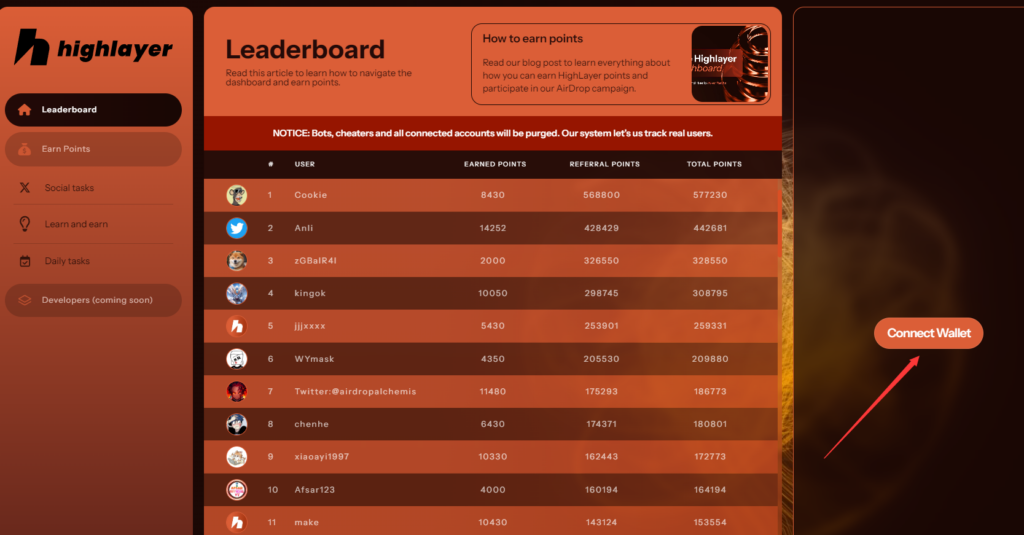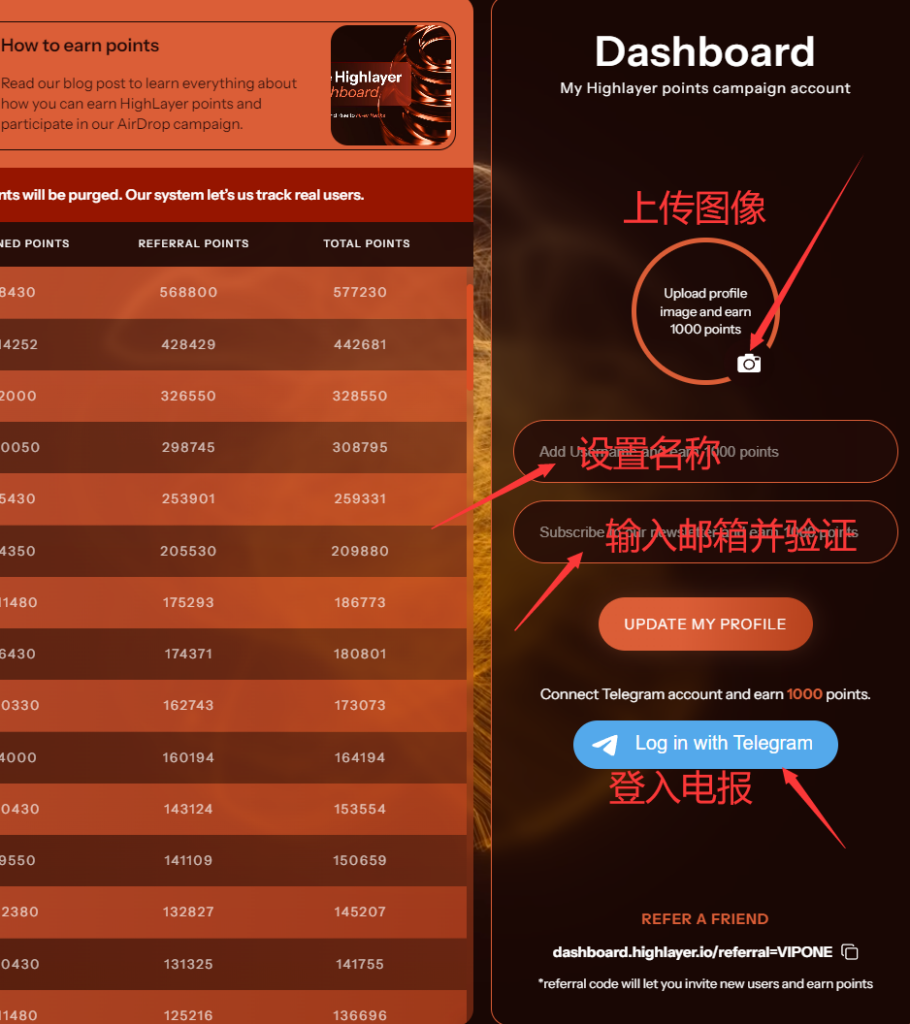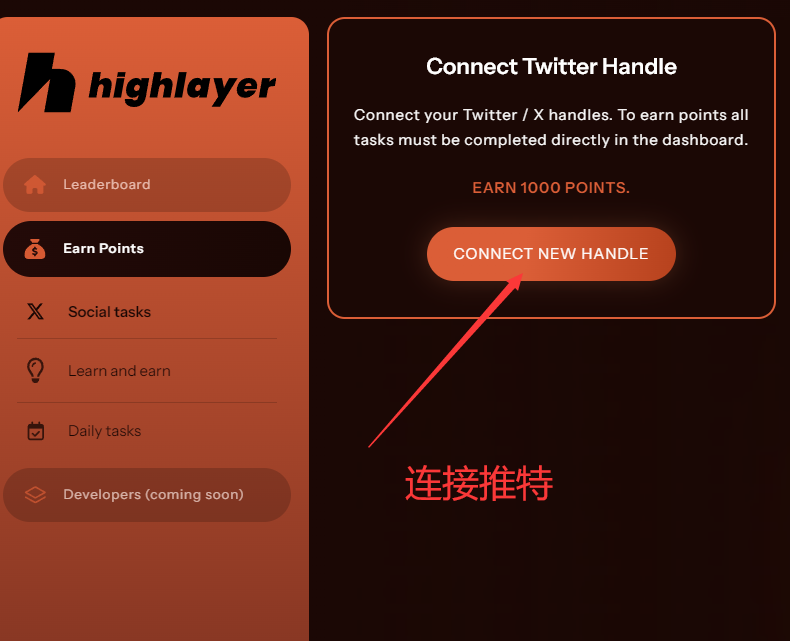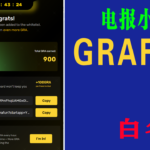没有融资, 没有热度, 有空就做一下吧。
项目地址 https://www.rootdata.com/zh/Projects/detail/Highlayer?k=MTMzMjE%3D
条件:
小狐狸钱包, 邮箱, 电报,推特, DC(非必须) , 任务完成会得10000分,以后每天再得50分。
一, 注册帐号
任务链接 https://dashboard.highlayer.io/?referral=VIPONE 邀请码 VIPONE 一定要有邀请码才行。
连接钱包
设置图像 可得1000分
设置昵称 可得1000分
输入邮箱并验证 可得1000分
连接电报 可得1000分


二, 社交任务
https://dashboard.highlayer.io/socials
评论, 点赞,转发, 基本上假任务, 点一下就可以关掉。但是一天不要点太多次。假任务也不要点太多。

三, 答题
里面有三套问题, 有5000分。答题后发个推,然后把推的链接给他。
第一套答案:
- Question 1: What is the primary programming language used in Highlayer’s Virtual Machine (HVM)? Answer: JavaScript
- Question 2: Which of the following is not a technological feature of Highlayer? Answer: Reduces the transaction fees on Bitcoin
- Question 3: What was the initial focus of blockchain? Answer: Trustless ledger for digital transactions
- Question 4: Which of the following is a blockchain-related limitation that prevents dApps from scaling to compete with non-decentralised applications? Answer: Data throughput dependent on the Layer 1
- Question 5: What challenge in blockchain development does Highlayer address with its JavaScript-based VM? Answer: High learning curve for Web2 developers
- Question 6: What is a key feature of Highlayer’s Self-Sustainable Data Availability System (SSDAS)? Answer: Permanent decentralised availability of transaction data
- Question 7: How does Highlayer’s hybrid execution model benefit the network? Answer: It allows for the efficient execution of heavy computational tasks without blocking other transactions by allowing parallelization (inspired by Solana)
- Question 8: What does Highlayer’s AK (AppKey) protocol improve in decentralized applications? Answer: User experience by reducing the need for constant interaction with the wallet provider
- Question 9: Which advanced technology is included in Highlayer’s HVM for improved smart contract functionality? Answer: Verifiable Delay Function (VDF) clock
第二套答案:
- Question 1: What is one of the primary scalability issues with traditional blockchains like Bitcoin and Ethereum? Answer: Low transaction throughput
- Question 2: What does transaction throughput refer to in the context of blockchain? Answer: The number of transactions per second (TPS) a blockchain can process
- Question 3: What is finality time in blockchain technology? Answer: The point at which a transaction becomes irreversible and permanently added to the blockchain
- Question 4: What is the transaction throughput of the Bitcoin network? Answer: 7 TPS
- Question 5: What is sharding in the context of blockchain scalability? Answer: Dividing the blockchain into smaller, more manageable pieces called shards
- Question 6: What are Appchains? Answer: Application-specific blockchains that operate independently, but can interoperate with a main blockchain or other appchains
- Question 7: What is the primary function of Layer 2 networks in blockchain technology? Answer: Building on top of existing blockchains to increase scalability by processing transactions off-chain
- Question 8: What is a notable limitation of Ethereum Layer 2 solutions? Answer: They still rely on the base layer for data, which can cause congestion
- Question 9: Why is reliance on an external centralized data layer problematic for Bitcoin Layer 2 solutions? Answer: It impacts the decentralization of the data
- Question 10: Which of the following is a reason why current Bitcoin Layer 2 rollups are problematic? Answer: All of the above
- Question 11: What is Highlayer’s hybrid execution model? Answer: A mix of sequential (like Ethereum) and parallel (like Solana) execution models
- Question 12: How does Highlayer’s hybrid execution model improve scalability? Answer: By allowing parallel processing of transactions where it matters most
- Question 13: What does Highlayer’s Self-Sustainable Data Availability System (SSDAS) address? Answer: Reliance on layer 1 for data or external data layers
- Question 14: What ensures the integrity and security of blockchain transactions in Highlayer? Answer: SSDAS
- Question 15: How does Highlayer’s SSDAS maintain data availability? Answer: By ensuring that transaction data is permanently available between the peers
- Question 16: How does Highlayer handle node data? Answer: All nodes contain a full copy of the blockchain ledger
第三套答案:
- Question 1: What is the primary purpose of rollups in blockchain technology? Answer: Enhance transaction throughput
- Question 2: How do Rollups enhance scalability for blockchain networks? Answer: By processing transactions off-chain
- Question 3: Which type of rollup operates on the assumption that all transactions are valid unless proven otherwise? Answer: Optimistic Rollups
- Question 4: What introduces latency in transaction finality for Optimistic Rollups? Answer: Challenge period
- Question 5: What is the major security risk associated with Optimistic Rollups? Answer: Actors submitting fraudulent state transitions
- Question 6: What is the purpose of the challenge period in Optimistic Rollups? Answer: To allow for the submission of fraud proofs
- Question 7: Which aspect of Optimistic Rollups can become problematic during network congestion? Answer: Submitting fraud proofs due to increased cost for submissions
- Question 8: What is an advantage of Zero-Knowledge Rollups over Optimistic Rollups? Answer: Faster transaction finality
- Question 9: What is the main disadvantage associated with Zero-Knowledge rollups? Answer: Computationally intensive proof generation
- Question 10: How does Highlayer’s architecture mitigate against risk of fraudulent state submissions? Answer: Self-evaluation of transactions
- Question 11: What approach does Highlayer take as an alternative to ORs or ZK-rollups? Answer: Sovereign roll-up with self-evaluation of network state
- Question 12: Which of the following is a role the Highlayer sequencer plays? Answer: Aggregating and ordering transactions quickly
- Question 13: How does Highlayer ensure censorship resistance if the sequencer fails? Answer: By allowing submission of Highlayer transactions via the Bitcoin Network
- Question 14: Which of the following is NOT a feature of Highlayer’s sovereign rollup architecture? Answer: Increased privacy
- Question 15: What is the primary issue with relying on external data availability solutions for rollups? Answer: Compromised data integrity
- Question 16: What does Highlayer use to ensure data availability, while retaining high scalability? Answer: Self-Sustainable Data Availability System (SSDAS)
- Question 17: What fundamental blockchain philosophy does Highlayer aim to adhere to? Answer: Censorship resistance and decentralization
四, 日常任务
任务链接 https://dashboard.highlayer.io/daily
打开访问一下就行。一天50分。
